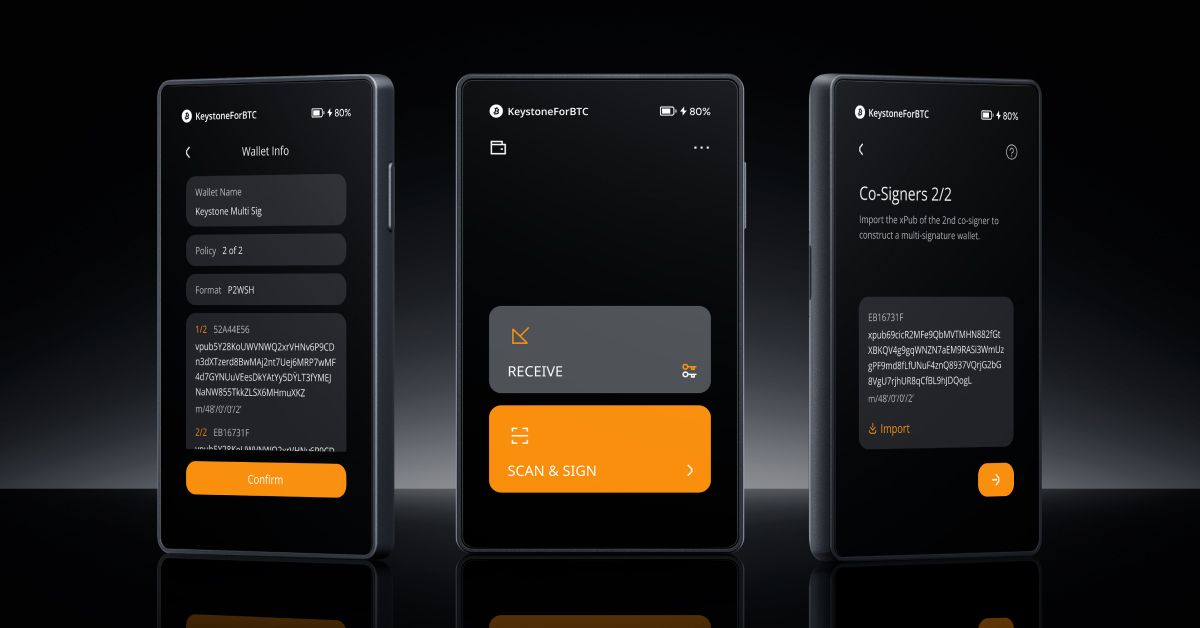Exploring the Power of Multi-Signature Wallets with Keystone

Multi-Signature Wallets: An Overview
Multi-signature wallets, or multisig wallets, represent a more sophisticated form of wallet that incorporates multiple sets of seed phrases into a single wallet. Unlike traditional wallets that require only one set of seed phrases, multisig wallets demand two or more.
These wallets also come with different spending requirements, necessitating multiple signatures to authorize a transaction. This can range from requiring 1 out of 2 signatures to 2 out of 3 or more, depending on the setup of the wallet.
The Advantages of Multi-Signature Wallets
Multi-signature wallets offer a significant advantage in terms of security. In order to execute a transaction, access to the correct set of signing keys is necessary, making theft much more challenging.
For example, in a 2 out of 3 multi-sig setup, two signing keys are required from a selection of keys stored in different locations. This adds an additional layer of protection against unauthorized access.
Imagine having one key at home, another at a bank, and a third with a lawyer or relative. With a 2 out of 3 multi-sig setup, you would need two of these keys to spend your money. It's worth noting that access to your watch-only wallet is essential for signing with your keys; otherwise, your signatures will be impossible to execute.
Who Should Consider Using Multi-Signature Wallets?
While there is no real silver bullet for achieving perfect security with your coins, self-custody is often considered a crucial starting point. Individuals with substantial holdings or those seeking heightened security should consider implementing multi-signature schemes to safeguard their coins effectively.
Factors such as one's security threat model and geographic location play a significant role in determining the suitability of multi-signature wallets. For instance, individuals residing in remote areas may opt for multi-signature wallets to mitigate security risks, even with lower bitcoin holdings.
Large institutions use multi-signature wallets often, small businesses might use a single signature wallet at times, there are many different reasons why someone might want to hold their coin with a multi-signature wallet.
Downsides of Multi-Signature Wallets
Despite their security benefits, multi-signature wallets come with their own set of challenges. Transaction costs tend to be higher due to the larger signatures involved, resulting in increased overall transaction costs.
Additionally, storing and managing multiple seed phrases and the extended public key (xpub) can be cumbersome, and the loss of any key or xpub could lead to permanent loss of access to funds.
It is very time consuming also to use this method, takes time to go to physical places if you have scattered it across a city, or a country, or multiple continents. Chance of losing access to one of your key is higher in this scenario if you are not careful enough.
Keystone‘s Multi-Signature
Implementing Multisig in Keystone
Keystone's approach to implementing multisig functionality prioritizes both security and user convenience. Ensuring the integrity of multisig transactions requires precise synchronization of critical details among co-signers, such as the Manufacturer FingerPrint (MFP), extended public key (xpub), and derivation path.
To simplify this synchronization process, Keystone offers two seamless methods of importing xpub: via SD card or QR code. This ensures that all co-signers are aligned and ready to participate in multisig transactions without any hassle.
How Keystone's Multisig Differs
Keystone stands out in the realm of hardware wallets by offering robust and user-friendly multisig capabilities. The cornerstone of multisig security lies in verifying co-signer public keys and transaction details. Human error poses the most significant vulnerability in multisig setups, but Keystone's 4-inch screen provides an intuitive interface for easily verifying transaction details, reducing the risk of asset loss due to human error.
Additionally, Keystone offers flexibility in choosing derivation paths, accommodating Native Segwit, Nested Segwit, and Legacy address types within multisig wallets.
Security is further enhanced by requiring the entry of the device unlock password as the final step in creating a multisig wallet. This additional authentication layer adds a safeguard against unauthorized access and ensures the integrity of multisig setups.
User-Friendly Interface and Interoperability
Keystone's large touchscreen simplifies the process of verifying co-signer information and confirming transaction details. The spacious display facilitates easy navigation and instills user confidence during multisig operations, reducing the likelihood of errors.
In addition to enabling users to import up to four multisig wallets on each wallet, Keystone also supports hidden wallets through passphrases, providing users with enhanced flexibility and support.
Furthermore, Keystone's commitment to interoperability sets it apart. Extensive research ensures compatibility with other hardware wallet brands like BitBox and ColdCard. Even in the event of Keystone's discontinuation, users can seamlessly recover their multisig wallets using alternative hardware wallets, safeguarding their assets and maintaining control over their funds.
By combining robust security measures with user-friendly design and interoperability, Keystone offers a comprehensive solution for users seeking to enhance the security of their holdings through multisig wallets.
For more information about Keystone's Bitcoin-only firmware, visit https://keyst.one/btc-only.
Follow us @KeystoneForBTC on Twitter for the latest product and #Bitcoin updates.
